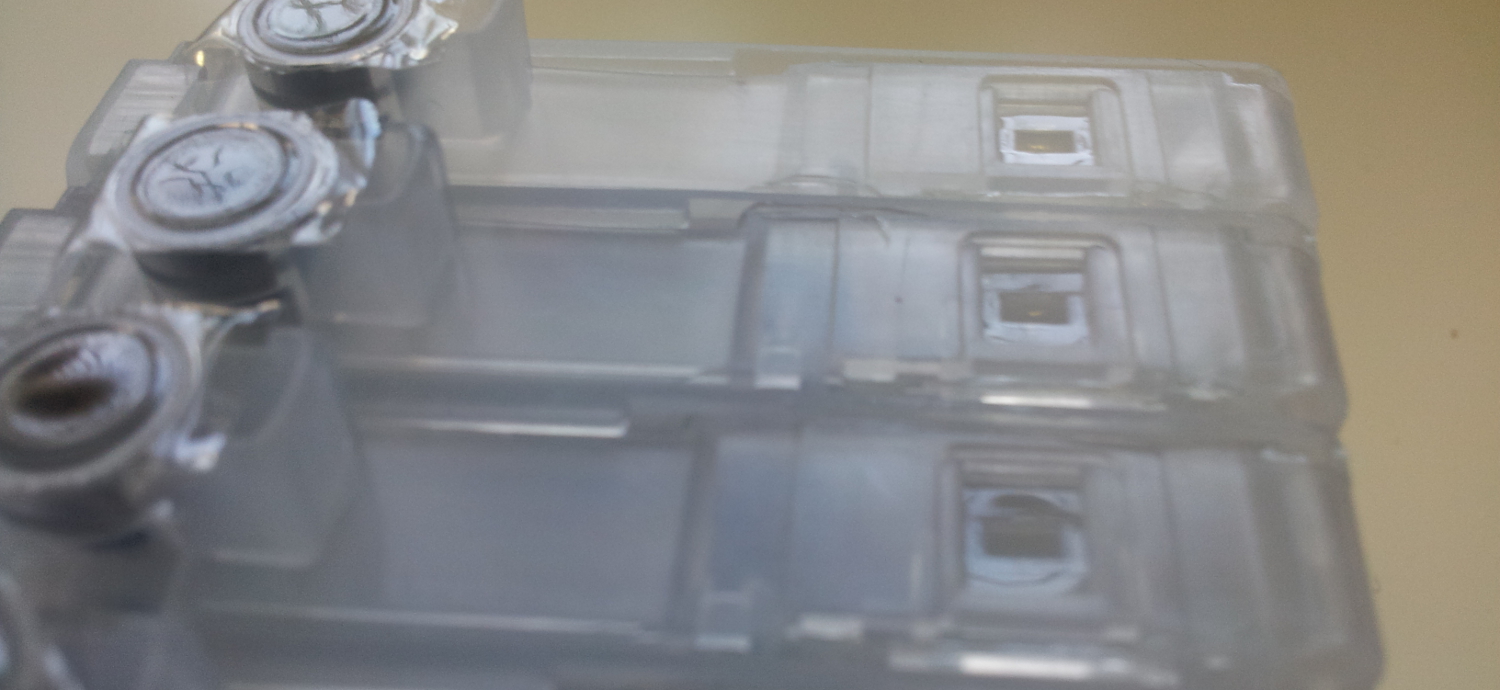How Epson Uses Canon / HP Solutions in Home Printers
In the summer of 2012, Epson introduced a new series of home inkjet printers and MFPs in the Expression Home XP series with mixed ink and dual dye control. Before that there were series: C / CX, R / RX, T / TX, S / SX, P / PX and L with a simple flow meter and one type of ink: pigmented or water-soluble.
What we have already seen in HP / Canon
In the new series, Epson began to combine ink for the first time - a black cartridge for printing text is filled with pigment, the remaining three or four cartridges (for images) - with water ink. Interestingly, such a “color ink” kit has always been used by Canon and HP in their home printers.
What does it give?
Another “innovation” of the line is lenses for additional ink level control. This is how they look on refillable cartridges for Expression Home XP.

The lens comes out triangular inside the inkwell. An LED shines on the lens below. If it is covered with ink, the light does not get on the photodetector, the lens is bare - the light is reflected in the photodetector. As a result, the printer informs the user that the ink has completely run out. This is especially convenient when you refill your cartridge, and the main counter (see below) has not understood anything for a long time.
This backup control system is used in conjunction with a software ink meter, which according to the given algorithms calculates how much dye is used up and correlates this data with the type of cartridge flashed in the chip (standard, XL, etc. - this reflects the volume). If the counter “thinks” that the ink is at zero — the work with this cartridge (read - with a chip) is blocked — therefore, refilling the original cartridges is useless. And this also necessitates the reset of chips on non-original consumables - CISS, PZK, etc. - with a button, removal or resetter.
I must say that reliable operation is ensured only by the joint work of two algorithms - the lens does not always work, and ink consumption is not always considered accurate.
In general, the changes are positive, but not for all users. I used to have the opportunity to buy a cheap inkjet printer with the ability to use CISS and pigment (or sublimation ink) to print the small runs of leaflets. Now no. According to user reviews, the new 4-flower beds with a combined type of ink, converted completely to pigment or sublimation, have a very clean part.
What we have already seen in HP / Canon
In the new series, Epson began to combine ink for the first time - a black cartridge for printing text is filled with pigment, the remaining three or four cartridges (for images) - with water ink. Interestingly, such a “color ink” kit has always been used by Canon and HP in their home printers.
What does it give?
- Saving on ink (with the same amount of water is cheaper), it’s true only for Epson (for the user, the price per milliliter is only growing - the volume of cartridges is less and less, the retail price does not change much)
- User-friendly - now in 4-color printers, the color ink in the print head dries less
- There was a simple opportunity to reduce the droplet size for color inks, which means to increase print resolution. The fact is that the usual “budget” pigment can clog narrow nozzle channels, therefore, the resolution on Epson 4-color “pigment” printers was lower than on 6-color ones that worked only on aqueous dyes.
Another “innovation” of the line is lenses for additional ink level control. This is how they look on refillable cartridges for Expression Home XP.

The lens comes out triangular inside the inkwell. An LED shines on the lens below. If it is covered with ink, the light does not get on the photodetector, the lens is bare - the light is reflected in the photodetector. As a result, the printer informs the user that the ink has completely run out. This is especially convenient when you refill your cartridge, and the main counter (see below) has not understood anything for a long time.
This backup control system is used in conjunction with a software ink meter, which according to the given algorithms calculates how much dye is used up and correlates this data with the type of cartridge flashed in the chip (standard, XL, etc. - this reflects the volume). If the counter “thinks” that the ink is at zero — the work with this cartridge (read - with a chip) is blocked — therefore, refilling the original cartridges is useless. And this also necessitates the reset of chips on non-original consumables - CISS, PZK, etc. - with a button, removal or resetter.
I must say that reliable operation is ensured only by the joint work of two algorithms - the lens does not always work, and ink consumption is not always considered accurate.
Like only partially
In general, the changes are positive, but not for all users. I used to have the opportunity to buy a cheap inkjet printer with the ability to use CISS and pigment (or sublimation ink) to print the small runs of leaflets. Now no. According to user reviews, the new 4-flower beds with a combined type of ink, converted completely to pigment or sublimation, have a very clean part.
